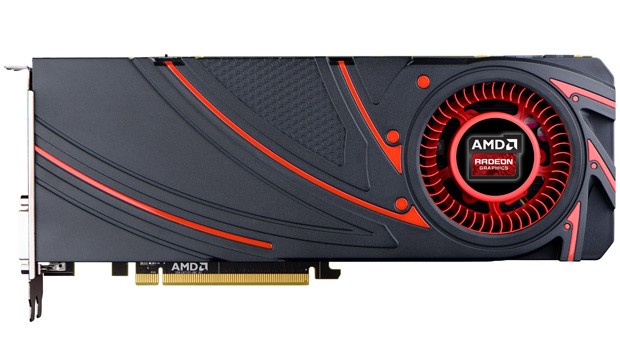Report: Radeon R9-290X Won't Need CFX Bridge, to be $600
It appears that the Radeon R9-290X won't need CrossFire bridges, and that it doesn't even have the ports.
Even after the AMD Hawaii event, a lot of information about the AMD Radeon R9-290X continues to trickle out from unofficial sources, the latest being from Donanimhaber. One thing that has come to see daylight, or rather, hasn't, is the lack of CrossFire connectors on the upcoming Radeon R9-290X graphics card. At first this might have been mistaken for being part of engineering samples, though on second thought a lot of sources are pointing to the use of "Sideport" technology.
Sideport technology is an older technology, last used in the Radeon HD 4870 X2. In other cards, both AMD and Nvidia have had to use bridge connectors to allow for enough bandwidth between the cards to operate together. Recent developments though, now allow otherwise. While the first PCIe specification, PCIe v1.0, had a bandwidth of about 4 GB/s (for a 16 lane PCIe slot), the PCIe v3.0 specification has almost 16 GB/s for the same slot. The upcoming PCIe v4.0 specification doubles that yet again. As such, the PCIe ports alone might provide enough bandwidth, rendering the use of a CrossFire bridge unnecessary.
Of course, it is very possible that this might still bring problems. For example, while most motherboards have a PCIe 3.0 x16 interface, what happens to some motherboards when more than one of these ports are populated is that a number of them (or all of them) have to share lanes, meaning that each port, or graphics card, effectively gets either eight lanes, or in some dramatic cases, just four lanes. That said, all of this is still speculation, so take it all with a grain of salt. It is very possible that AMD might not be calling it 'Sideport' technology but perhaps something else.
The AMD Radeon R9-290X is expected to hit retail starting October 15 for a rather surprising price. Numerous sources, including Softpedia, indicate that the card will cost just $599.
Get Tom's Hardware's best news and in-depth reviews, straight to your inbox.
Niels Broekhuijsen is a Contributing Writer for Tom's Hardware US. He reviews cases, water cooling and pc builds.
-
Smawell I had always wondered why something wasn't built into cf capable boards and cards anyways. Could have sworn I saw pics of it with them though, maybe it was an early ref model. Cool news though, one less thing to forget in future builds lol!Reply -
slomo4sho Shouldn't this read "Rumor: Radeon R9-290X Won't Need CFX Bridge, to be $600" since the price is nothing more than a rumor.Reply
Alternatively, you can call it "Radeon R9-290X Won't Need CFX Bridge, price rumored to be $600" -
Smawell Reply11635718 said:Shouldn't this read "Rumor: Radeon R9-290X Won't Need CFX Bridge, to be $600" since the price is nothing more than a rumor.
Alternatively, you can call it "Radeon R9-290X Won't Need CFX Bridge, price rumored to be $600"
+1 Didn't notice the price wasn't final, trusted the title too much lol -
nikoli707 the price will be $600. i can't understand how anyone would doubt that. makes no sense whatsoeverReply -
vmem if the performance rumors and price is correct, this card will be a steal for the holiday seasonReply -
Smawell Would you guys recommend a cf 7950, just adding one to my existing. Or getting a new R9 this holiday? I'm leaning at cf but I hate that my PC generates so much heat in my room.Reply -
vmem On a different note:Reply
Again, I'm an AMD fan (not fanboi) myself, but this literally means you can't CF this card on ANY AMD system until they refresh their chipset and include more x16 PCIe 3.0 lanes that are not shared. In fact, you can pretty much only do this on a few very high-end Intel boards... -
silverblue Isn't there an FX board with PCIe 3.0 capability?Reply
http://www.asus.com/Motherboards/SABERTOOTH_990FXGEN3_R20/
Apologies if I've misinterpreted you. -
vmem Reply11636342 said:Isn't there an FX board with PCIe 3.0 capability?
http://www.asus.com/Motherboards/SABERTOOTH_990FXGEN3_R20/
Apologies if I've misinterpreted you.
Nope, that one only has 16X PCIe 3.0 lanes TOTAL. in CF, those will get split and shared between the two slots, or 8X PCIe 3.0 lanes, essentially the same bandwidth as two 16X PCIe 2.0 lanes. we know that a 7970 or gtx 680 can already saturate PCIe 2.0. so yeah, not enough bandwidth to run a pair of R9-290x in crossfire...

